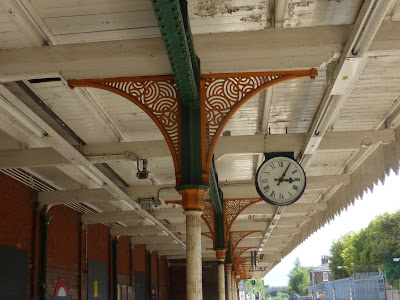
This is the 6th station that I have visited on the Central line as I continue on my quest to research Above the Underground.The Central line used to be nicknamed the 'Twopenny Tube' as it introduced the first flat fare when it opened in 1900. This lasted until 1907 when the cost increased to three pence for travelling to 8 stations or more but the nickname lasted for much longer.
 |
 Although the line continues on from Woodford for some of the trains this is the terminus. Although the line continues on from Woodford for some of the trains this is the terminus. |
I exited on the South side of the station.
Once the railway arrived here in 1856, the population soon increased from 4,609 in the 1871 census to 13,798 in 1901. Woodford was first mentioned in the Doomsday book ( a record of the settlements in England and part of Wales completed in 1086 ) as Wdefort. The name is Old English and means 'ford in or by a wood'. The ford refers to a crossing of the River Roding.

This is known as Woodford Bridge. The Roding river still runs beneath the bridge although there was not much water flowing through today. Looking in the other direction is a view of Roding Valley Park.

Above the bridge is this large roundabout with the motorway M11 thundering over the road. The ancient parish of Woodford consisted of 4 villages: Church End (now South Woodford), Woodford Green, Woodford Wells and the original settlement at Woodford Bridge situated beside the important river crossing of the Saxon London to Newmarket Highway.


Walking under the motorway I came across the sign for the village of Woodford Bridge.

This Victorian water pump was saved when the 1771 bridge was replaced in 1962 and has been returned to the site of the ancient river crossing.
Walking back towards the station I passed a large green park with many mature trees which makes you aware that we are still close to Epping Forest.

Close to the station I walked passed this pub. I think this is the third pub called The Railway Tavern that I have seen close to a Central Line station!
There is a subway taking you beneath the railway lines to the other side of the station.


This side of the station looks greener. In fact just across the road from the station is Pankhurst Green, named after Sylvia Pankhurst (1882-1960), the suffragette. She came to live in Woodford in 1924 - 1956. She was the second daughter of Emmeline Pankhurst, the founder of the Suffragette movement.
Across the road from the Green is The Broadway with its reataurants, shops and cafes.
Snakes Lane connects Woodford Bridge to the South of the station and Woodford Green on the North.


At the end of Snakes Lane West you come onto The High Road with more shops, banks, restaurants and pubs. It used to just be a forest track linking London with Epping Heath and was such until the 17th cent. By the end of the 16th cent large houses were being built. There are three significant surviving buildings in Woodford Green: Hurst House, Highams and Harts House.

Hurst House was known originally as The Naked Beauty and is probably the oldest surviving building in the area. It is believed the name referred to a statue in the garden of the house. The central core of the building was built around 1714 by a brewer, Henry Raine. The house was lived in by wealthy city merchants until the late 19th cent when it became Woodford House School. Before the first World War the house became a private residence again.


This is Highams, designed by William Newton and was erected in 1768 by Anthony Bacon MP and was for many years the Walthamstowe Manor House of Higham Bensted. The building was used as a temporary hospital during the First World War before becoming Woodford County High School.

The third significant building is Hart's House. In 1617 Sir Humphrey Handforth, Master of the Wardrobe to James I, built a mansion called Harts on this site. It was rebuilt in 1816 and is used today as a nursing home.

This was once the gatehouse at the entrance of Harts House. This Grade II listed building is now a private residence with lots of car memorabilia in the garden.


Close to the Hart's estate is a large, modern fire station built in 1992

Back on the High Road is the Castle Hotel, a former posting house which has been here for 200 years. The third storey and ornate cast iron balcony are late 19th cent and were probably added when the building was enlarged to cater for the huge number of day trippers visiting the forest nearby.

This large building dominates the corner of the High Road and Snakes Lane West. Once a bank, it is now a Greek restaurant. The High Road has quite a mixture of buildings interspersed with green areas and ponds.

Shops across the road from one of the ponds on the High Road
This building was once Woodford Green Working Men's Club. Originally built as a chapel for independent Wesleyans in 1869. A replacement church was built elsewhere and in 1904 was bought by Sir J Roberts who presented it for public use. In 2005 it was converted to residential accommodation.


Elm Terrace built in 1873
At the other end of the Green stands a bronze statue of Sir Winston Churchill, who was the Member of Parliament for Woodford from 1924-1964.


















































